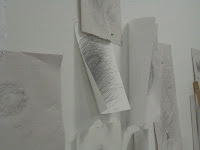Materials
For the Modular Madness project, I chose to use pool noodles as my subject. I decided to cut them up, because I felt that it added a bit more dynamics to the artwork. Dynamic in such a way that you had to look at it for a second before you realized that the piece was made using pool noodles.
I had some troubles in the beginning of this piece. For one, I tried not cutting the noodles up, and using a wire interior. The initial test showed that wire wasn’t going to work in holding the noodle in any fun wiggle shape or loop. They are surprising strong for something made out of just foam. I even tried tripling up the wire, but to no ail.
In the end, I decided to turn the cut pieces into another pool object, and by keeping to form what the toy was – a kid’s pool toy. I thought that it was great for a recycled piece, where you can turn on toy into another.
The pool noodles did not rise to scale from the initial pieces. It kept to pretty much the same size (just slightly larger). The multiple noodles got turned into one piece. There wasn’t too much use of space within the piece. It was all pretty solid.
The piece did change a lot from the original idea. I had stated out wanting to turn them into a more simplistic piece, where I was to cut and glue them onto a piece of white foam board. The idea was to create an abstraction of Fruit Loops in Milk. The second idea was to put wire in the middle, and make a fun, squiggly knot of pool noodles. The third, I was to make a moveable sheet. The forth, to make a PVC box and hanged the pieces, where people can walk through it.
The final was to make a raft and have it so that kids can stack the noodles into fun buildings and things.
Craftsmanship
The craftsmanship was good, but the overall piece wasn’t mindboggling. It was all pretty average in my opinion. I put it together using hot glue and made it so that you couldn’t see the glue unless you are sitting right close to it, looking for the glue. I even disguised some unglued pieces into the work of art, so that it can be moved around and played with, in the same aspect that I wanted children to come and play with it.
While talking about the elements and principals of form in this Modular Madness piece, I’d have to say that point is the main element. The noodle pieces come out looking like colorful doughnuts all stacked or glued together. There is a mixture of abstract and geometric in the piece that can look a little messy, but still feel functional. It compares greatly to a child’s room. There is function in the room, but a child has come and added a bit of chaos into it. It’s functional and playful.
Concept
In searching the back ground of pool noodles I hit a snag. There wasn’t much online about the history of the noodle, just what it was made of and who makes it. There wasn’t much that talked about when it became a child’s toy, and how was it developed for children. The only name I could get was that Stephen Motosko came up with the idea in 1999.
I was able to keep the same function of the piece as it was originally meant for; a toy for children to play with in a pool.
Presentation
In the presentation of this piece, I should have presented it in water. It would have changed the outlook of the piece. I was, however, uncertain I could do that in a classroom setting. Instead, I displaied it in an area where it was the most secluded from the other artworks. I also picked out an area where there were monochromatic artworks. This way the color of the pool noodles didn’t clash with the surroundings. I also pressed the piece where a white wall could act as a nice background.

































